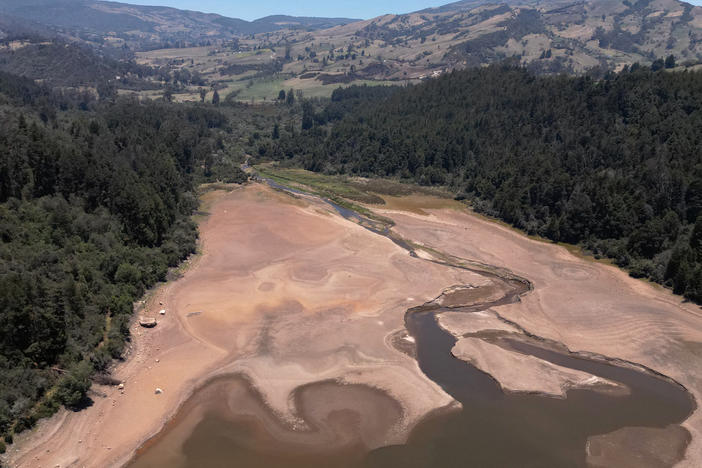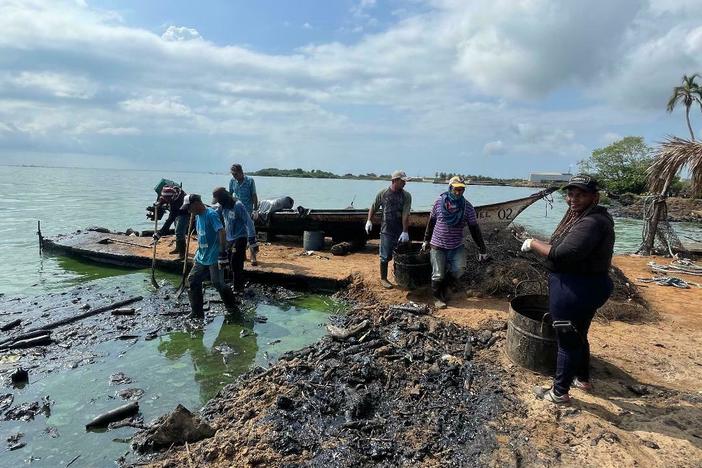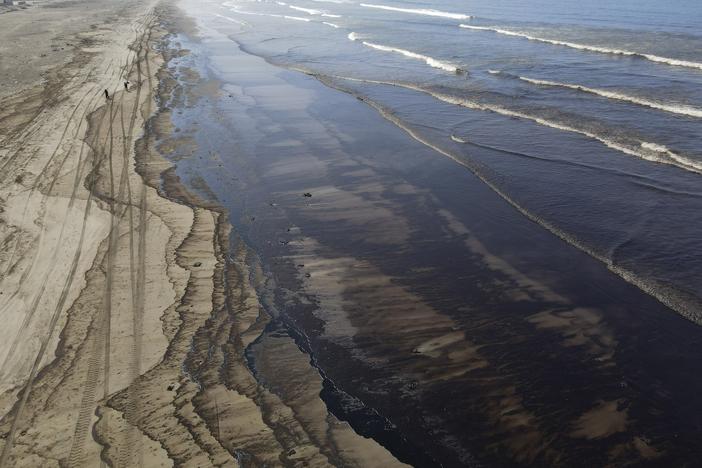Section Branding
Header Content
As demand for electric cars grows, Chileans face the effects of lithium mining
Primary Content
The South American country of Chile has become a center of lithium mining, which has boomed as demand for electric car batteries has risen. But what are the environmental costs?
Transcript
SCOTT SIMON, HOST:
Around the world, demand for lithium is skyrocketing. The metal is used to make lithium-ion batteries for electric cars, solar panels and other green technologies. And all of this has led to a boom in lithium mining, especially in Chile, where NPR's John Otis filed this report.
(SOUNDBITE OF WATER PUMP RUNNING)
JOHN OTIS, BYLINE: This is a lithium mine in the Atacama Desert in northern Chile. Pumps are bringing salty groundwater called brine to the surface where it's stored in a series of enormous pools.
(SOUNDBITE OF WATER RUNNING)
OTIS: That's the sound of this greenish salt brine that contains lithium. It's being transferred from one of the brine pools to another.
The brine is 10 times saltier than seawater and ranges in color from Caribbean blue to green to mustard yellow. Marcelo Valdebenito, an executive for Albemarle, a U.S. company that operates this mine, explains why.
MARCELO VALDEBENITO: (Speaking Spanish).
OTIS: He says that as the sun evaporates the brine, it changes color as the lithium becomes more concentrated. The whole evaporation process takes 18 months.
VALDEBENITO: This is the final part of the process with the brine have a 6% lithium concentrate.
OTIS: And that's why it's yellow because it's very concentrated?
VALDEBENITO: Yeah.
OTIS: It feels like you're dipping your fingers in to olive oil.
Next, the lithium solution is turned into a white powder and shipped abroad to make batteries. They're in huge demand as nations phase out gasoline vehicles and build more wind farms and solar power plants.
UNIDENTIFIED PERSON: (Speaking Spanish).
OTIS: In just the past year, lithium prices have jumped six-fold. That's good news for Chile, Argentina and Bolivia. These three South American countries are known as the lithium triangle and together hold more than half of the world's proven lithium reserves. Annual lithium production here at the Albemarle Mine has increased from 22,000 tons to 84,000 tons. Ignacio Mehech is the firm's country manager in Chile.
IGNACIO MEHECH: We are growing as the demand is growing, and today, we are a much bigger company than what we were just five years ago.
OTIS: Even so, the region's lithium output is just a fraction of what it could be. Due to technological and environmental challenges, Bolivia hardly produces any. Economic turmoil has kept Argentina from opening more mines. Due to high taxes and strict mining regulations in Chile, Mehech points out that Albemarle is one of just two foreign lithium companies operating here.
MEHECH: The regulation is not clear or easy.
OTIS: Really? It would be difficult to get a new...
MEHECH: It is very difficult. And that's why you don't see more lithium companies in Chile.
OTIS: But some Chileans prefer a go-slow approach. They include microbiologist Cristina Dorador.
CRISTINA DORADOR: (Speaking Spanish).
OTIS: Speaking on Skype, she says lithium mines extract huge amounts of groundwater from the Atacama Desert, making the region even hotter and drier. She recently co-authored an investigation linking lithium mining to a reduction in the local flamingo population.
DORADOR: (Speaking Spanish).
OTIS: With so much pressure from the world to produce more lithium, she says, the price is going to be paid by Chile's environment. Andres Diaz, who directs the Centre for Energy and Sustainable Development in Santiago, the Chilean capital, says Chile ought to export more than just lithium. He thinks the country should produce and export higher valued lithium ion batteries, which Chile currently imports at a steep cost.
ANDRES DIAZ: For us, it doesn't make any sense to export lithium and then buy into other countries' batteries with material that we produce at the very beginning.
OTIS: To move in that direction, Albemarle signed an agreement with the Chilean government to spend $300 million on research and development here.
(SOUNDBITE OF BULLDOZER RUNNING)
OTIS: Back at the mine, a bulldozer is moving white mounds of salt leftover from lithium extraction. It's a surreal sight, like plowing snow in the middle of the desert. But Marcelo Valdebenito, the Albemarle executive showing me around, sees something else.
VALDEBENITO: It's really, really a beautiful place because here is the place where born the lithium that move the world.
(CROSSTALK)
OTIS: Indeed, for him, the water pumps, the bulldozers and the brine pits inspire visions of a greener future. John Otis, NPR News, in the Atacama Desert, Chile. Transcript provided by NPR, Copyright NPR.
Bottom Content



